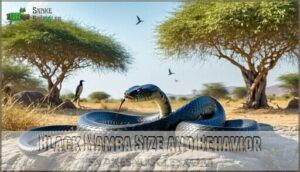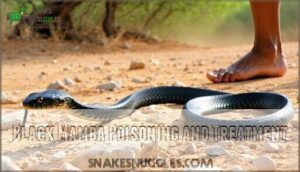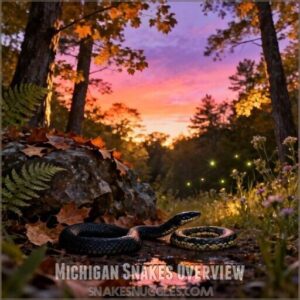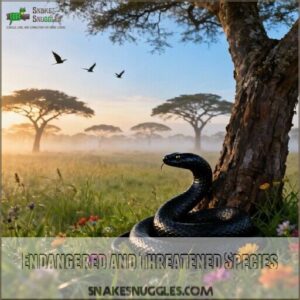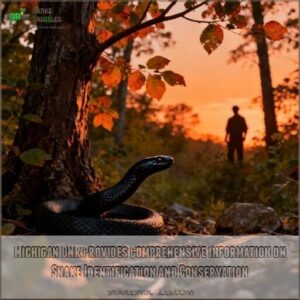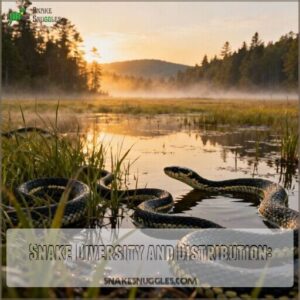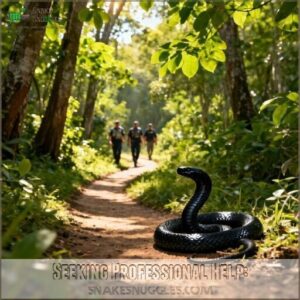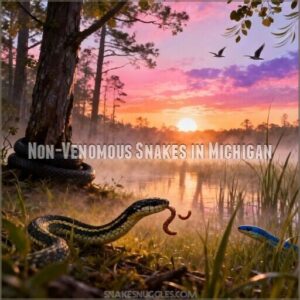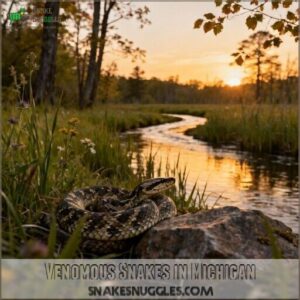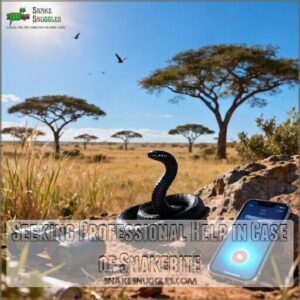This site is supported by our readers. We may earn a commission, at no cost to you, if you purchase through links.
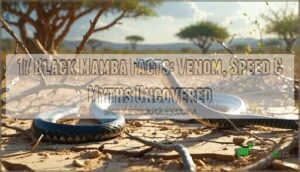
Yet behind the legends lies a creature more complex than its deadly reputation suggests. These sleek predators aren’t actually black, rarely attack without provocation, and play a role in African ecosystems that scientists are only beginning to understand.
The gap between myth and reality is where the most interesting facts emerge—where you’ll discover why this snake’s name is misleading, how its venom rewrites the rules of neurotoxicity, and what separates folklore from the documented behavior of one of Africa’s most misunderstood top predators.
Table Of Contents
- Key Takeaways
- Black Mamba Myths
- Black Mamba Characteristics
- Black Mamba Size and Behavior
- Black Mamba Venom
- Black Mamba Poisoning and Treatment
- Michigan Snakes Overview
- Non-Venomous Snakes
- Endangered and Threatened Species
- Michigan, Home to a Diverse Array of Snakes
- State’s Rich Snake Population Includes Non-venomous and Venomous Species
- Michigan DNR Provides Comprehensive Information on Snake Identification and Conservation
- Snake Diversity and Distribution:
- 17 Identified Snake Species:
- Eastern Hognose Snake: Interesting Behavior, Plays Dead When Threatened
- Fox Snake: Eastern Fox Snake is Threatened, Non-venomous
- Kirtland’s Snake: Endangered, Found in Southern Lower Peninsula
- Northern Ribbon Snake: Common in Wetland Areas, Great Swimmers
- Habitat Preferences:
- Woodlands: Some Snakes Thrive in Forested Regions
- Wetlands: Certain Species Are Adapted to Marshy Areas
- Meadows: Snakes Can Be Found in Grassy Fields
- Blue Racer: Notable for Declining Population, Non-venomous, Tail Shaking When Threatened
- Brown Snake: Common, Non-venomous, Often Found Under Objects
- Butler’s Garter Snake: Common, Non-venomous, Primarily Feeds on Earthworms
- Venomous Snakes:
- Snake Safety and Conservation:
- Safety Precautions:
- Avoid Contact: Keep a Safe Distance From Snakes, Do Not Attempt to Handle or Disturb Them
- Respect Snake Habitats: Be Mindful of Snake Presence in Natural Areas
- Educate Yourself: Learn About Snake Identification and Behavior to Minimize Encounters
- Conservation Efforts:
- Habitat Preservation: Protecting Natural Habitats is Crucial for Snake Survival
- Public Education: Raising Awareness About The Importance of Snakes in Ecosystems
- Legal Protections: Some Snake Species in Michigan Are Protected by Law
- Seeking Professional Help:
- Snake Bite Treatment:
- Remain Calm: Stay Calm and Avoid Sudden Movements
- Seek Medical Attention: Call for Emergency Medical Assistance Immediately
- Immobilize The Area: Keep The Bitten Area Still and Below Heart Level
- Avoid Tourniquets: Do Not Apply a Tourniquet
- Snake Identification:
- Take a Photo: if Possible, Take a Photo of The Snake From a Safe Distance
- Consult Experts: Provide The Photo to Experts for Identification
- Michigan’s Snake Diversity
- Non-Venomous Snakes in Michigan
- Venomous Snakes in Michigan
- Seeking Professional Help in Case of Snakebite
- Frequently Asked Questions (FAQs)
- How do black mambas communicate with each other?
- How intelligent are black mambas compared to other snake species?
- What is the average lifespan of a black mamba in captivity?
- Do black mambas have any natural predators other than mongooses and eagles?
- What is the role of black mambas in the African ecosystem?
- How fast can black mambas move on land?
- What is the black mambas average lifespan?
- How do black mambas reproduce and care for young?
- What are black mambas main natural predators?
- When is black mamba breeding season?
- Conclusion
Key Takeaways
- Black mambas aren’t actually black—their name comes from the inky-black interior of their mouths, while their bodies display grey to olive-brown scales, making this one of Africa’s most ironically named predators.
- The venom delivers a neurotoxin-cardiotoxin cocktail with an LD₅₀ of just 0.32 mg/kg, and a single bite injects 100-120 mg—enough to kill 19 humans—with death occurring in 7-15 hours without antivenom treatment that must be administered immediately.
- Despite their reputation as aggressive hunters, black mambas are shy and reclusive, retreating when possible and only striking repeatedly when cornered, with most bites being defensive "dry bites" that serve as warnings rather than attacks.
- These snakes reach speeds of 12-14 mph in short bursts and grow 2-3 meters on average (up to 4.5 meters), making them the world’s second-longest venomous snake and exceptionally agile hunters across diverse African habitats from rocky outcrops to woodlands.
Black Mamba Myths
You’ve probably heard wild stories about black mambas—snakes that supposedly chase down cars, ambush travelers, or possess supernatural powers. Let’s cut through the folklore and look at what’s real.
Mamba Attack Myths paint these snakes as calculating predators that plan assaults on humans, even coiling around vehicle wheels to strike unsuspecting drivers. That’s pure fiction. Black Mamba Behavior shows they’re actually shy creatures that avoid confrontation. Tales of mambas chasing horseback riders? Unsubstantiated folklore. The myth about them rolling downhill by gripping their tails? Biologically impossible.
Some communities attribute mystical intelligence to black mambas—balancing on tails, creating whirlwinds with Snake Speed Facts reaching superhuman levels. Scientific research reveals the truth: their behavior is instinctual, not magical. Their name comes from the black interior of their mouths, not mysticism.
Here’s the real story on Deadly Encounters: black mambas retreat when possible. Bites happen when they’re cornered or threatened. They warn you first—opening that distinctive black mouth before striking. Most bites are actually "dry bites" without Venom Effects, serving as warnings rather than attacks.
Understanding Black Mamba characteristics means recognizing them as defensive, not aggressive predators. The city of Durban is a prime example of successful urban snake conservation efforts.
Black Mamba Characteristics
Now that you’ve separated fact from fiction, you need to see what makes the black mamba one of Africa’s most formidable reptiles. This member of the Elapidae Family has a slender snake body reaching 2-3 meters, with some specimens stretching to 4.5 meters—making it the world’s second-longest venomous snake. Its smooth snake scales shimmer in shades of grey to olive-brown, not black, while the inky-black mouth interior gives this mamba species its name.
Black Mamba Behavior shows diurnal activity patterns in diverse mamba habitat zones—from rocky outcrops to woodland areas. The venom composition delivers a deadly neurotoxin-cardiotoxin cocktail through 6.5mm fangs.
Black Mamba Size and Behavior
You’ve seen the mamba’s striking appearance—now let’s break down exactly how big these serpents get and what drives their legendary behavior. Most adults stretch 2-3 meters, though some reach a staggering 4.5 meters—cementing this Elapidae family member as Africa’s most feared snake. Their coffin-shaped heads house 6.5mm fangs capable of precise venom delivery.
Black Mamba Behavior reveals fascinating contradictions:
- They’re diurnal hunters, prowling snake habitat zones from rocky outcrops to woodlands during daylight hours
- Despite their reputation, they’re shy and reclusive, preferring escape over confrontation
- When cornered, they’ll strike repeatedly with mamba speed reaching 20 km/h across open ground
- They hunt birds, rodents, and other snakes—injecting prey then waiting for paralysis before swallowing whole
Their agility on both ground and trees showcases outstanding Black Mamba Behavior and Biology adaptations for survival.
Black Mamba Venom
The mamba’s power flows through its venom—a biochemical weapon that’s changed how we grasp snake toxicity. Venom Composition here breaks the mold: at least 41 distinct proteins form this cocktail, dominated by dendrotoxins and three-finger toxins like alpha-neurotoxins and fasciculins. Unlike most venomous snakes, black mamba venom contains minimal phospholipase A2 and virtually no protease enzymes.
Toxicity Levels reveal staggering potency—an LD₅₀ of just 0.32 mg/kg in mice, while a single bite delivers 100-120 mg on average. That’s enough to kill 19 humans. Snake bites from this species trigger rapid neurotoxic venom effects: muscle paralysis, respiratory failure, cardiovascular collapse. Symptoms can surface within 10 minutes, with death occurring in 7-15 hours without treatment.
Antivenom Research continues advancing, but geographic variation complicates treatment—Kenyan and South African mamba venom differ markedly in composition and tissue impact. Understanding the effects of mamba venom is vital for developing effective antivenom treatments.
Black Mamba Poisoning and Treatment
When facing a black mamba bite, survival hinges on immediate action. Without antivenom, the untreated fatality rate approaches 100%, making this venomous snake one of Africa’s deadliest threats. Neurotoxin impact begins within 10 minutes, triggering a metallic taste, drooping eyelids, and muscle weakness. Collapse can occur within 45 minutes as venom effects cascade through your nervous system. Death from respiratory paralysis usually follows in 7-15 hours without treatment.
Emergency response demands specific protocols:
- Apply pressure immobilization starting above the bite site, covering the entire limb
- Remove constricting jewelry immediately to prevent tissue damage
- Never use tourniquets—they’re contraindicated in black mamba envenomation
- Keep the affected area still and below heart level
- Seek medical attention instantly; call emergency services
- Prepare for intubation if respiratory paralysis develops
- Administer SAIMR polyvalent antivenom intravenously: initial antivenom dosage is 20 ml (2 vials)
- Treatment outcomes improve dramatically with prompt intervention—post-1962 mortality dropped from 43% to 13% in treated cases
Snake bite treatment and prevention saves lives when seconds count.
Michigan Snakes Overview
Michigan shelters 17 snake species across its woodlands, wetlands, and meadows—a reflection of the state’s ecological richness that most residents never fully appreciate. Unlike the Black Mamba’s African domain, Michigan species thrive in temperate zones where snake habitats range from marshy lowlands to rocky uplands.
Wildlife management efforts focus on snake conservation, particularly for threatened species like the Eastern Fox Snake and the endangered Kirtland’s Snake. Only one species delivers venomous bites: the Eastern Massasauga Rattlesnake. Snake identification and safety are crucial here—knowing your local reptiles prevents unnecessary panic while fostering coexistence with creatures that control rodent populations and maintain ecological balance.
| Species Category | Notable Examples | Conservation Status |
|---|---|---|
| Common Non-venomous | Eastern Garter Snake, Black Rat Snake | Stable populations |
| Threatened Species | Eastern Fox Snake | Declining, protected |
| Venomous | Eastern Massasauga Rattlesnake | Special concern status |
Non-Venomous Snakes
Most snakes you’ll cross paths with in Michigan won’t harm you—they’re the unsung pest controllers keeping rodent populations in check across your backyard and local trails. Snake identification matters for snake safety: understanding reptile conservation needs and snake behavior patterns helps you coexist peacefully with these creatures in their natural snake habitats.
Species diversity here is impressive: the Eastern Garter Snake thrives in nearly every habitat, recognizable by its striped pattern and reddish tongue. The Black Rat Snake, Michigan’s longest nonvenomorous species, climbs trees with ease and enjoys legal protection under wildlife preservation statutes. Blue Racers shake their tails defensively when cornered—a bluffing behavior that mimics rattlesnakes without the venom. Brown Snakes hide beneath logs and debris, while Butler’s Garter Snakes specialize in earthworm diets.
Endangered and Threatened Species
When survival hangs by a thread, some species slip toward the edge while the rest of us remain blissfully unaware of their quiet disappearance. Michigan’s endangered reptiles face habitat loss and fragmented ecosystems that threaten their existence. While black mamba conservation efforts dominate headlines in Africa, Michigan’s venomous snakes—like the Eastern Massasauga Rattlesnake—need equal attention.
Species conservation here demands wildlife protection for:
- Copper-bellied Water Snake: This endangered species clings to southern wetlands, where habitat loss decimates populations faster than conservation efforts can counteract.
Threatened ecosystems don’t announce their collapse. Kirtland’s Snake and Queen Snake populations decline quietly, reminding us that endangered species protection isn’t optional—it’s survival.
Michigan, Home to a Diverse Array of Snakes
You’ll find more than just rattlesnakes slithering through the Great Lakes State—seventeen distinct snake species call Michigan home, each one a fundamental thread in the ecological tapestry. From the Eastern Garter Snake weaving through wetlands to the Black Rat Snake climbing woodland canopies, Michigan’s snake diversity reflects ecosystem balance at work.
Snake habitat ranges from marshy shores to dry meadows, with each species contributing to reptile conservation and Michigan wildlife protection through predator-prey dynamics. Snake research continues revealing how these creatures maintain the state’s ecological integrity.
State’s Rich Snake Population Includes Non-venomous and Venomous Species
From harmless garden helpers to the state’s only rattlesnake, Michigan’s seventeen snake species split into two camps: those you can safely admire up close and the one that demands your respect from a distance. Non-venomous species dominate Snake Habitat Diversity here—Black Rat Snakes control rodents in barns while Eastern Garter Snakes patrol wetland margins. These creatures embody Wildlife Management at its finest, maintaining ecosystem balance without human intervention.
The Eastern Massasauga Rattlesnake stands alone as Michigan’s sole Venomous Species. Unlike the fearsome Black Mamba of Africa, this shy rattler rarely crosses paths with humans. Snake Safety here means simple awareness: watch where you step in marshy areas, respect their space, and they’ll respect yours.
Reptile Research reveals these animals aren’t threats—they’re solutions. Each species fills a niche that keeps Michigan’s ecosystems functioning. Snake Conservation efforts protect both common and threatened populations, ensuring future generations inherit this biological diversity. Understanding Michigan Snakes transforms fear into fascination.
Michigan DNR Provides Comprehensive Information on Snake Identification and Conservation
The Michigan DNR website hands you the field guide you didn’t know you needed—complete with identification photos, range maps, and conservation status updates that turn every backyard snake encounter into a learning opportunity instead of a panic.
You’ll find detailed profiles covering Snake Habitat preferences, Species Research findings, and Wildlife Management strategies that protect threatened populations.
Their Snake Identification tools break down physical markers—scale patterns, head shapes, behavior quirks—so you can distinguish harmless Michigan Snakes from the state’s lone Venomous Snake.
This resource transforms Snake Safety from guesswork into confidence, supporting Snake Conservation while maintaining Ecosystem Balance across the state’s diverse landscapes.
Snake Diversity and Distribution:
Michigan hosts 17 documented snake species, each occupying distinct ecological niches across the state. You’ll encounter these serpents in varied landscapes, from dense forests to open wetlands.
Here’s what you need to know about the species that call Michigan home.
17 Identified Snake Species:
If you’re serious about understanding Michigan’s reptiles, you need to know this: seventeen distinct snake species call this state home, each one carved by evolution to fill a specific niche in the ecosystem. Species classification here ranges from the imposing Black Rat Snake—Michigan’s largest—to the Eastern Massasauga Rattlesnake, the state’s only venomous snake.
Snake habitats vary widely. You’ll find some in woodlands, others in wetlands, and several thriving in meadows and gardens. Snake behavior differs too. The Blue Racer shakes its tail when threatened, mimicking a rattlesnake. The Brown Snake hides under objects, preferring secrecy over confrontation.
Conservation status matters. Some species are common, like the Eastern Garter Snake. Others face threats. Understanding snake species characteristics—from venom types to feeding patterns—reveals how these predators maintain ecological balance. Unlike the Black Mamba of Africa, Michigan’s snakes are adapted to temperate climates and pose minimal threat when left undisturbed.
Eastern Hognose Snake: Interesting Behavior, Plays Dead When Threatened
Among Michigan’s seventeen species, the Eastern Hognose stands out as nature’s most theatrical con artist—this snake doesn’t just retreat, it stages its own death scene. When threat response kicks in, you’ll witness animal mimicry at its finest: the snake flips belly-up, mouth agape, tongue lolling, releasing musk to sell the act. This snake defense tactic—thanatosis—confuses predators seeking live prey.
Snake behavior like this reveals reptile biology shaped by survival pressure. Found in hognose habitat ranging from woodlands to sandy areas, this non-venomous species uses snake camouflage and dramatic displays instead of venom.
Wildlife conservation efforts protect this performer, whose animal behavior teaches us evolution’s creative power.
Fox Snake: Eastern Fox Snake is Threatened, Non-venomous
Slithering through Michigan’s wetlands and marshes, the eastern fox snake wears a threatened label that demands our respect and action. Habitat loss and fragmentation threaten this nonvenomous hunter. You’ll recognize it by its yellowish-brown scales with dark blotches—snake identification skills that prevent confusion with rattlesnakes. Fox snake behavior includes tail vibration when cornered, mimicking venomous species despite being harmless. Wildlife conservation efforts focus on protecting remaining wetland corridors. Your support for wildlife preservation strengthens threatened species recovery.
Reptile and wildlife conservation depends on understanding these snakes’ ecological role:
- Eastern fox snakes control rodent populations in agricultural areas, benefiting farmers while maintaining wetland ecosystem balance.
Snake conservation starts with you.
Kirtland’s Snake: Endangered, Found in Southern Lower Peninsula
Hidden beneath logs and concrete debris in Michigan’s vanishing wetlands, Kirtland’s snake clings to survival in the southern Lower Peninsula—a snake so rare that finding one feels like discovering a secret the earth almost forgot to keep.
Habitat loss tears apart their world as wetlands drain and development spreads. You’re witnessing endangered species on the brink. Reptile conservation and ecology demand habitat preservation now—protecting these secretive burrowers means safeguarding ecosystem balance.
Wildlife protection isn’t abstract. Snake conservation starts when you defend their vanishing ground.
Northern Ribbon Snake: Common in Wetland Areas, Great Swimmers
Sleek as a liquid shadow, the Northern ribbon snake flows through Michigan’s wetlands with a swimmer’s grace that most terrestrial serpents can only envy. You’ll spot these aquatic adaptations masters in marshy zones where wetland ecology thrives. Ribbon snake behavior reveals evolution’s artistry—slender bodies built for gliding through water, hunting amphibians with precision. Unlike the venomous snake or feared black mamba, they’re harmless hunters. Snake identification becomes easy: three bright yellow stripes against dark scales.
Habitat conservation protects their world:
- Wetland destruction erases their hunting grounds
- Snake migration patterns shift as marshes vanish
- Snake conservation demands protecting aquatic corridors
- Every drained marsh silences their swimming ballet
- Snake habitat preservation ensures their survival
Habitat Preferences:
Every snake species has its own story written in the landscape it calls home, and Michigan’s serpents are no exception. You’ll find woodland dwellers threading through leaf litter beneath tree canopies, while wetland specialists claim marshy territories with swimmer’s precision. Open meadows host their own hunters, adapted to grassland pursuit.
Unlike the black mamba of sub-Saharan Africa—equally comfortable as arboreal climbers in savanna habitats or terrestrial hunters prowling rocky outcrops across SubSaharan regions—Michigan’s snakes reveal snake habitat preferences shaped by forest ecosystems and local terrain, each species mastering its chosen domain.
Woodlands: Some Snakes Thrive in Forested Regions
When you step into Michigan’s forests, you’re entering territory where certain snake species don’t just survive—they own it. Forest ecology shapes their camouflage and hunting strategies. These woodland serpents navigate forest floors with precision, slipping beneath leaf litter where shadows become armor.
Unlike the black mamba—that Sub-Saharan Africa legend equally skilled as an arboreal climber and ground hunter—Michigan’s forest dwellers rarely climb trees. They’ve mastered a different game. You’ll find them threading through undergrowth, controlling rodent populations in ways that matter for woodland conservation.
Some venomous snakes share these snake habitats, but most species here aren’t interested in confrontation—just survival.
Wetlands: Certain Species Are Adapted to Marshy Areas
You won’t find black mambas here, but Michigan’s wetlands shelter snakes that’ve cracked the code on marshy survival—where water meets mud, specialized hunters wait in the reeds. Northern ribbon snakes glide through shallow water with startling grace, their bodies adapted for aquatic life in ways Africa’s most feared snake never needed.
These wetland specialists regulate ecosystem balance by controlling amphibian populations, maintaining water quality through their place in marsh ecology. You’ll spot them basking near cattails or threading between lily pads—moves that’d make any venomous snake jealous.
Their snake behavior reflects perfect wetland conservation: they’re indicators of healthy snake habitat, thriving where oxygen-rich water meets dense vegetation. When marsh ecology falters, they vanish first.
Meadows: Snakes Can Be Found in Grassy Fields
Grassy fields hold their own serpent secrets—snakes that’ve mastered open terrain where cover is scarce and predators scan from above. While black mamba dominates Africa’s most feared snake list through speed, Michigan’s meadow specialists rely on different tactics.
These grassy habitats support meadow biodiversity critical to field ecology—though no venomous snakes here match the neurotoxic punch of their African cousin.
Your grassland conservation efforts protect species demonstrating exceptional snake behavior through:
- Cryptic coloration matching dried grasses
- Freeze responses when threatened
- Seasonal snake migration between meadow and woodland
- Rapid strikes for rodent control
- Thermoregulation on sun-warmed stones
These snake habitat zones demand respect—even without mambas lurking.
Blue Racer: Notable for Declining Population, Non-venomous, Tail Shaking When Threatened
Michigan’s Blue Racer can’t match the black mamba’s lethal reputation, but it’s vanishing just as fast from landscapes where it once thrived. This non-venomous species suffers from habitat loss as development fragments the open terrain it needs.
When threatened, you’ll witness racer behavior that mimics rattlesnakes—rapid tail vibrations against dry leaves create convincing warnings without venom to back them up. Population decline accelerates despite wildlife education efforts emphasizing snake identification and conservation.
Unlike venomous snakes requiring immediate medical response, Blue Racers pose zero threat to you. Their tail signals represent pure bluff—a survival strategy losing ground as snake conservation and ecology battles against shrinking habitats.
Brown Snake: Common, Non-venomous, Often Found Under Objects
Flipping over a piece of plywood in your backyard might reveal one of Michigan’s most overlooked residents—the brown snake. This nonvenomous species masters object refuge and burrowing techniques, using camouflage methods to vanish beneath rocks, logs, and debris in moist habitats.
Habitat selection drives their survival:
- You’ll spot them under objects where moisture lingers
- Snake behavior shows preference for shaded ground cover
- Snake identification is simple—small size, brown coloring, no threat
Habitat preservation protects these common allies in snake conservation and ecology.
Butler’s Garter Snake: Common, Non-venomous, Primarily Feeds on Earthworms
Not every garter snake hides—Butler’s garter snake hunts earthworms right out in the open, patrolling moist meadows and marshlands where its favorite prey thrives. This nonvenomous snake shows animal adaptations that maintain ecological balance: you’ll spot it in snake habitats where soil stays damp.
Its earthworm diet makes it a specialist predator. Reptile behavior differs from black mamba aggression—Butler’s garter snake remains docile. Wildlife conservation protects garter snake populations across their range.
Venomous Snakes:
You can identify venomous snakes by looking at specific physical features that set them apart from harmless species. In Michigan, these markers help you recognize the Eastern Massasauga Rattlesnake—the state’s only venomous snake.
Here’s what to watch for when you’re out in the field.
Identification Tips:
Recognizing venomous snakes starts with knowing what to look for, and a few key features make all the difference. In Michigan, where Africa’s most feared snake doesn’t roam, you’ll still benefit from understanding snake identification basics.
Look for:
- Triangular head shape — broader than the neck, unlike non-venomous species
- Elliptical pupils — vertical slits rather than round eyes
The Eastern Massasauga Rattlesnake, Michigan’s only venomous snake, displays these characteristics.
Scale patterns and color variations provide additional habitat clues for confident identification.
Triangular Head: Venomous Snakes Often Have Triangular-shaped Heads
A triangular head acts like nature’s warning label—wider than the neck, packed with venom glands, and built for business. This head morphology signals danger across species, from Michigan’s Eastern Massasauga to Africa’s black mamba. Snake identification hinges on recognizing these triangular features—they’re not decorative but functional, housing the venom delivery system that makes venomous snakes so formidable.
| Feature | Purpose |
|---|---|
| Broad skull base | Houses enlarged venom glands |
| Distinct neck narrowing | Creates the triangular warning profile |
| Muscular jaw structure | Powers precise venom delivery |
Elliptical Pupils: Slit-like Pupils Are a Sign of Venomous Snakes
Slit pupils slice through dim light like precision instruments—built for ambush predators who work the margins between day and night. Pupil shape evolution gifted venomous snakes like the Eastern Massasauga this vertical opening, maximizing nocturnal snake vision when prey’s most vulnerable.
But here’s where venomology gets interesting—pupil shape variation doesn’t guarantee venom correlation myth aside. Michigan’s harmless hognose rocks round pupils yet hunts dusk same as any rattler. That pupil camouflage advantage? It’s about survival timing, not toxicity.
Rattle: Eastern Massasauga Rattlesnakes Have a Rattle at The End of Their Tails
That rattle’s a keratin warning system—each segment built from hardened skin left behind at every shed. Rattlesnake behavior turns tail vibrations into sonic territoriality—those rattle sounds pulse at 50+ cycles per second, pure snake communication saying back off.
The Eastern Massasauga rattlesnake, Michigan’s only venomous snake, shakes before venom delivery. It’s self-preservation, not aggression.
Snake Safety and Conservation:
You don’t need to fear snakes, but you do need to respect them. Understanding how to share space with these animals keeps both you and them safe.
Here’s what you should know about staying safe around snakes and protecting the species that need our help.
Safety Precautions:
Most snake encounters end badly because people ignore one simple rule: distance is your best defense. Don’t try touching wild snakes—even non-venomous ones bite when threatened. If you spot one, freeze, then back away slowly.
Understanding venomous snake behavior helps you avoid snake bites entirely. Learn the basics of snake bite first aid before exploring areas with venomous snake activity.
Protective gear essentials like boots and long pants reduce your risk. Emergency response plans matter when seconds count. Snake venom toxicity varies, but respecting all species equally keeps you safe during wild snake encounters.
Avoid Contact: Keep a Safe Distance From Snakes, Do Not Attempt to Handle or Disturb Them
Treating snakes like unpredictable wildlife instead of curious pets is the difference between a story you tell and a trip to the emergency room. Here’s your survival checklist for Wildlife Encounters:
- Stay six feet back—venomous snake strikes rarely exceed half their body length
- Never corner them—Risks increase dramatically when escape routes disappear
- Watch for Snake Warning signs—coiled posture means imminent Venomous Bites
- Photograph from distance—zoom beats proximity for identifying Venomous Animals safely
Snake Behavior dictates your response. Safe Distance isn’t cowardice—it’s Wildlife Conservation in action.
Respect Snake Habitats: Be Mindful of Snake Presence in Natural Areas
Walking through Michigan’s wetlands and forests without basic snake awareness is like driving blindfolded—you’re gambling with outcomes you can’t afford to lose. Ecosystem balance depends on your environmental awareness when entering natural areas. Wildlife preservation starts with simple respect:
- Step heavily in dense vegetation—ground vibrations alert snakes to your presence, preventing surprise encounters while maintaining habitat preservation.
Snake habitat conservation means leaving rocks, logs, and vegetation undisturbed. Reptile habitat integrity crumbles when you rearrange their world for curiosity’s sake.
Educate Yourself: Learn About Snake Identification and Behavior to Minimize Encounters
Beyond habitat respect lies a sharper truth: knowledge transforms fear into power. Learning to identify Michigan’s snakes by their markings and movements gives you control over your own safety.
Study venomous snake identification features—triangular heads, elliptical pupils, body patterns—alongside snake behavior patterns like defensive posturing or retreat signals.
This wildlife conservation mindset prevents unnecessary snake safety incidents while protecting both you and the serpent. Bite prevention starts with recognition, not panic.
Conservation Efforts:
Protecting snakes isn’t just about saving individual species—it’s about keeping entire ecosystems from falling apart. These predators maintain ecological balance by controlling rodent populations and serving as prey themselves. Your support for wildlife conservation directly impacts species diversity and environmental protection. Here’s how conservation efforts work:
- Habitat preservation safeguards critical snake territories through land trusts and protected zones.
- Snake research provides data on population health and species management needs.
- Public education programs shift fear into respect for biodiversity and species preservation.
- Legal protections prevent habitat destruction and guarantee threatened species survive.
These conservation efforts strengthen the ecological web that sustains all life.
Habitat Preservation: Protecting Natural Habitats is Crucial for Snake Survival
You can’t defend a species if you’ve already destroyed the ground it lives on. Habitat loss and human encroachment threaten black mambas across sub-Saharan Africa, fragmenting their territories and disrupting ecological balance. Climate change compounds these pressures, altering prey availability and forcing snakes into conflict zones.
That’s why habitat preservation demands immediate action—protected areas create refuge zones where wildlife conservation efforts can actually take root. Reptile habitat restoration rebuilds degraded territories, reconnecting fragmented landscapes that support hunting and breeding. Conservation groups work to secure land corridors, enabling snake populations to move freely without encountering human settlements.
| Threat | Conservation Response |
|---|---|
| Habitat Loss | Establish Protected Areas and wildlife corridors |
| Human Encroachment | Create buffer zones between settlements and snake territories |
| Climate Change | Restore degraded habitats with native vegetation |
| Prey Depletion | Maintain ecosystem integrity to support food chains |
Public Education: Raising Awareness About The Importance of Snakes in Ecosystems
Land gets protected, but people still fear the snakes living there—and that’s where education changes everything. Wildlife education and awareness programs dismantle myths, revealing how ecosystem balance depends on predators like black mambas controlling rodent populations. Environmental education transforms fear into respect, showing communities how biodiversity protection strengthens their own survival.
Conservation efforts and initiatives that work:
- Teaching identification skills prevents unnecessary killings while promoting ecological balance and species diversity
- Community workshops demonstrate how snake conservation protects crops by eliminating pest outbreaks
- School programs connect children to wildlife ecology, building future generations of habitat preservation advocates
- Local guides share knowledge about wildlife preservation, turning former snake killers into conservation partners
Legal Protections: Some Snake Species in Michigan Are Protected by Law
Michigan’s wildlife laws draw a protective line around certain snake species, making it illegal to harm or capture them without proper authorization. Conservation laws shield endangered species like Kirtland’s Snake and threatened populations like the Eastern Fox Snake from extinction. Legal enforcement backs these species protection measures, ensuring Michigan’s snake diversity survives habitat loss.
You’ll face penalties for violating wildlife regulations—respect these boundaries. Habitat preservation fuels conservation efforts, maintaining ecological balance across woodlands and wetlands. Understanding endangered lists helps you recognize which snakes deserve extra protection in wildlife conservation initiatives.
Seeking Professional Help:
If you encounter a snake in Michigan, knowing what to do can save your life. Quick, calm action matters most when dealing with a potential bite.
Here’s how to respond and when to get expert help.
Snake Bite Treatment:
When venom races through your veins at the speed of fear itself, every decision you make becomes a lifeline—or a fatal mistake. Snake Bite Treatment demands precision. Here’s your survival protocol:
- Call emergency services immediately—Antivenom administration is your only defense against Snake Venom Toxicology
- Immobilize the Wound Care area and position it below heart level to slow venom spread
- Never apply tourniquets or attempt Venom Removal—this worsens tissue damage
- Monitor Bite Symptoms: numbness, paralysis, difficulty breathing require urgent Emergency Response
- Photograph the Venomous Snake from a safe distance for accurate First Aid guidance
Your life depends on swift, informed action.
Remain Calm: Stay Calm and Avoid Sudden Movements
Panic is venom’s greatest ally, turning a manageable emergency into a life-threatening cascade. When a venomous snake strikes, your body’s panic response floods your system with adrenaline—accelerating your heart rate and pushing venom faster through your bloodstream.
Sudden movements compound this danger. Thrashing after a snake attack amplifies circulation, transforming a survivable bite into a critical emergency.
Stay still. Breathe deliberately. Calm behavior isn’t weakness—it’s your most powerful survival tip against snake behavior’s deadliest consequence.
Seek Medical Attention: Call for Emergency Medical Assistance Immediately
Every second counts when black mamba venom starts its assault—call emergency services before symptoms escalate beyond control. Black mamba venom works fast, attacking your nervous system within minutes. You don’t have time to second-guess. Dial emergency services immediately and describe what happened—where the snake bite occurred, what the snake looked like, and any symptoms you’re experiencing.
If you’re in remote areas, send someone for medical help while you stay still. Don’t wait for symptoms to worsen before seeking urgent care. Antivenom exists, but only medical professionals can administer it properly. The faster you get first aid and emergency response, the better your chances of surviving this deadly snake’s assault.
- Report critical details: Tell dispatchers the exact bite location on your body, the time of the snake attack, and any neurological changes you notice—tingling, blurred vision, or difficulty breathing.
Immobilize The Area: Keep The Bitten Area Still and Below Heart Level
Keeping the bite site motionless isn’t optional—movement pumps venom through your bloodstream faster than your body can manage. Splint the affected limb if possible, using anything rigid nearby—sticks, rolled magazines, or even cardboard.
Position the wound care area below heart level to slow venom distribution. This first aid step buys critical time before emergency response teams arrive with medical treatment for venomous snake bites.
Avoid Tourniquets: Do Not Apply a Tourniquet
Tourniquets do more harm than good—they trap venom in limb tissue, causing irreversible damage while the clock keeps ticking. Cutting off blood flow concentrates snake venom in one area, triggering tissue death and potential amputation.
Venomous wound care demands different tactics than standard trauma response. Instead of constricting, focus on keeping the affected area immobile and below heart level.
Professional medical treatment options—specifically antivenom—work by neutralizing venom systemically, not by isolating it. Emergency response teams need circulation intact to deliver life-saving interventions effectively.
Snake Identification:
If a snake crosses your path, knowing what you’re looking at can mean the difference between peace of mind and a panicked call to emergency services. Snake identification requires sharp observation of specific biological markers—head shapes, scale features, and tail characteristics all tell distinct stories. While Michigan hosts no species remotely resembling Africa’s most feared snake, the black mamba, understanding venomous snake biology remains essential. Venomous species display triangular heads and elliptical pupils, while harmless snakes show rounded features. Snake patterns and venom types vary dramatically across species.
Your smartphone becomes your greatest ally here:
- Capture clear photos from six feet away, documenting the snake’s head profile, body patterns, and tail—experts use these details to distinguish between harmless water snakes and dangerous rattlesnakes.
Document the exact location and contact local wildlife authorities immediately for professional identification.
Take a Photo: if Possible, Take a Photo of The Snake From a Safe Distance
Photographing the snake gives medical professionals concrete evidence to work with—a blurry shot of body patterns beats a panicked description every time. Stay at least six feet back—venomous snake strikes rarely exceed half their body length. Use your phone’s zoom function rather than stepping closer.
Focus on the head shape and body markings; these details separate harmless water snakes from rattlesnakes instantly. Snake identification through photo evidence transforms guesswork into certainty when seconds matter.
Consult Experts: Provide The Photo to Experts for Identification
Once you’ve captured that photo, send it straight to your local poison control center, hospital emergency department, or wildlife expert—they’ll identify the species in minutes while you’re en route to treatment.
Expert identification eliminates dangerous guesswork—misidentifying a harmless snake as venomous wastes antivenom, while mistaking Africa’s most feared snake for something benign proves fatal.
Wildlife consultation services and venomous detection specialists provide species verification that directly shapes your treatment protocol.
Michigan’s Snake Diversity
Seventeen distinct species call this Midwestern state home, and understanding them can reshape how you see the wilderness around you. From woodlands to wetlands, Michigan’s snake diversity reflects a delicate ecosystem balance that deserves your attention.
The Black Rat Snake, Michigan’s largest, hunts through forested regions. The Eastern Massasauga Rattlesnake, the state’s only venomous species, inhabits marshy areas where few expect danger. Each snake habitat tells a story of adaptation and survival.
Wildlife management efforts focus on species conservation, particularly for threatened populations like the Eastern Fox Snake. Reptile research reveals these creatures aren’t threats—they’re pest controllers maintaining nature’s order.
While you won’t find a Black Mamba in Michigan’s forests, the venomous snake you might encounter, the Eastern Massasauga Rattlesnake, demands respect. Understanding these species transforms fear into appreciation, enabling you to coexist with the wild.
Non-Venomous Snakes in Michigan
Most people overlook the quiet guardians living beneath logs and in the grass, yet these harmless serpents form the backbone of Michigan’s pest control system. Michigan Wildlife Management recognizes sixteen nonvenomous snakes among the state’s seventeen species, each contributing to ecological balance through rodent population control.
Key Michigan Nonvenomous Species:
- Eastern Garter Snake — Michigan’s most common snake, identified by distinctive red tongues and striped patterns
- Black Rat Snake — The state’s largest species, protected under Michigan Snake Laws for its declining numbers
- Blue Racer — Notable for tail-shaking defense behavior and decreasing populations requiring Snake Conservation Efforts
- Butler’s Garter Snake — Earthworm specialist thriving in wetland margins
- Brown Snake — Urban adapter found beneath debris in developed areas
Snake Habitat Preservation initiatives protect these species while educating communities about their value. Michigan’s Snake Diversity and Habitat showcase nature’s pest management system—free, effective, and self-sustaining when you let it work.
Venomous Snakes in Michigan
Only one rattlesnake calls Michigan home, and it’s wrapped in more myth than menace. The Eastern Massasauga Rattlesnake represents Michigan’s sole venomous species—a shy creature more likely to retreat than strike. You’ll recognize this Snake Habitat specialist by its triangular head, elliptical pupils, and the distinctive rattle warning you from a safe distance.
Unlike the Black Mamba’s aggressive reputation, this rattlesnake embodies caution. Snake Behavior studies show it freezes when threatened, relying on camouflage before ever using venom. Michigan Conservation efforts protect this species despite unwarranted fear driving persecution.
Venom Research confirms bites remain exceptionally rare when you practice Wildlife Safety basics: watch your step in wetlands, respect its space, and never attempt touching. Understanding Venomous Snake Safety and Identification transforms fear into appreciation. Michigan’s Snake Diversity and Habitat depend on coexistence—this rattlesnake controls rodents while asking only to be left alone.
Seeking Professional Help in Case of Snakebite
A snakebite doesn’t mean certain death, but your response in those first minutes shapes everything that follows. Stay calm—panic accelerates venom circulation. Call for Emergency Response immediately. While waiting for Professional Assistance, immobilize the affected limb below heart level. This slows toxin spread without risking tissue damage from tourniquets, which worsen Snake Attack outcomes.
Snakebite First Aid means knowing what not to do: skip cutting, sucking, or ice application. Proper Medical Treatment requires hospital-administered Antivenom, developed through rigorous Toxin Research and Development. If safe, photograph the snake for Venomous Snake Safety and Identification—accurate species recognition directs appropriate venom removal protocols.
Michigan’s Eastern Massasauga bites rarely prove fatal with prompt treatment. Understanding Snake bites and venom mechanics transforms fear into measured action. Your survival hinges on swift medical intervention, not wilderness heroics.
Frequently Asked Questions (FAQs)
How do black mambas communicate with each other?
Snake signals tell the story. Black mambas rely on visual displays—raised heads, flattened necks, and aggressive posturing—to communicate threat displays and establish boundaries.
Africa’s most feared snake rarely vocalizes, but that hissing sound? It’s a final warning before striking.
How intelligent are black mambas compared to other snake species?
Like a chess master reading moves ahead, black mambas display sophisticated snake intelligence through adaptive behavior and spatial memory. Comparative psychology studies show their reptile cognition surpasses many snake species—they learn escape routes, remember threats, and adjust hunting tactics.
Africa’s most feared snake combines speed with calculated decision-making, not just instinct.
What is the average lifespan of a black mamba in captivity?
In captivity, black mambas usually survive 10 to 12 years. Some individuals push past 20 years when captive breeding programs prioritize reptile health and proper mamba care.
This longevity surpasses many venomous snakes, proving Africa’s most feared snake adapts well to controlled environments with consistent wildlife conservation practices.
Do black mambas have any natural predators other than mongooses and eagles?
You’ll find that black mamba predators extend beyond the usual suspects. Crocodiles occasionally take black mambas when opportunities arise near water.
Larger snake species also consume juvenile mambas, creating a fascinating ecosystem balance where Africa’s most feared snake isn’t entirely untouchable in the wild.
What is the role of black mambas in the African ecosystem?
You’ll find black mambas serving as top predators in African ecosystems, maintaining prey population control through their hunting of rodents and birds.
Their presence helps regulate food chain dynamics and preserves habitat diversity, preventing rodent-driven disease spread across the landscape.
How fast can black mambas move on land?
Speed is everything when you’re built to strike before prey can react. Black mambas reach land speeds of 12-14 mph in short bursts, making them among the fastest snakes worldwide and exceptionally agile hunters across African terrain.
What is the black mambas average lifespan?
In the wild, black mambas usually live 11 to 15 years. Survival rates depend on age factors like predation, habitat quality, and human encounters.
Captivity extends mamba lifespan to around 20 years, where venom impact from hunting stress is eliminated.
How do black mambas reproduce and care for young?
Black mambas breed from September to February, with females laying 10-25 eggs in decaying vegetation.
The mother provides no parental care, abandoning the nest immediately after egg laying.
Hatchlings emerge fully venomous and independent .
What are black mambas main natural predators?
Despite their fearsome reputation, Africa’s most feared snake faces threats from wild mongooses, large eagles, and secretary birds.
Mongoose attacks are particularly effective—these agile predators use quick reflexes and animal defense strategies to avoid the aggressive snake’s strikes while delivering fatal bites.
When is black mamba breeding season?
Breeding cycles for this venomous snake occur from September through February, following cooler temperatures between April and June.
Males wrestle for mating rights during Mamba Courtship, displaying Africa’s most feared snake at its most competitive.
Conclusion
What separates the black mamba from folklore’s exaggerations? Understanding these 17 interesting facts about black mamba snakes transforms fear into informed respect.
You’ve seen how speed, venom potency, and defensive behavior intersect with habitat loss and human encroachment. The snake’s name misleads—its mouth, not skin, earns that descriptor. Neurotoxic venom causes rapid paralysis, demanding immediate antivenom intervention. Yet attacks remain rare unless provocation occurs.
Recognition of these realities doesn’t diminish the species’ formidable nature; it clarifies where caution ends and myth begins, granting you the discernment to coexist with Africa’s most misunderstood top predator.

